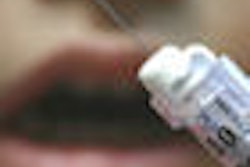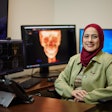
Some visits to the dentist are unforgettable. When she was 12 years old in Amarillo, TX, Salley Shannon was referred by her orthodontist to a general dentist for a tooth extraction. The root was long, the anesthetic wasn't enough, and Shannon yelped in pain.
Instead of sympathizing, the dentist called for his assistant to buckle her to the chair and hold onto her head. Forty-six years later, the experience still gives Shannon nightmares.
"I have this terrible fear of being strapped down and having somebody do something to me," she said. "It's very hard to make myself go to the dentist. I put it off and put it off. It's hard for me even to take my children."
Shannon is not alone. About 10% of the population fears the dentist, and at least some evidence (such as a 2002 review in the International Journal of Paediatric Dentistry, November 2002, Vol. 12:6, pp. 392-397) suggests that traumatic childhood experiences underlie that anxiety. Partly for that reason, opposition to coercive techniques appears to have grown. Last year the American Academy of Pediatric Dentistry (AAPD) added new cautions to its guidelines on restraint.
But the academy stopped far short of banning all types of what it calls "stabilization." And there are important reasons why any general dentist who works with children may want to master the art.
Graphic video
It's easy to see why many dentists shy away from these techniques. Aside from the fear of inflicting the kind of psychological damage that haunts Shannon, dentists who restrain their patients can run afoul of public opinion. In 2006, graphic video footage of a sobbing child being restrained in a Small Smiles clinic that specializes in Medicaid -- along with interviews of current and former staff -- led to a law enforcement investigation.
That report, by WJLA TV station in Washington, DC, portrayed the clinic as routinely restraining patients in papoose boards to reduce the amount of time needed for each patient visit and thereby maximize revenue. It described young patients wetting their pants and screaming for parents barred from the operatory while the clinic performed multiple procedures.
But the reality is different from these appearances, according to a spokesperson for the national chain of dental clinics. Doctors at Small Smiles have to work fast to meet the needs of so many kids who show up with severe disease, wrote Don Meyers in an e-mail to DrBicuspid.com. "Our dentists often see kids who are 4, 5, or 6 years old and have never been to a dentist before. These children often have severe tooth decay that requires immediate attention."
And, he stated, the clinic didn't overuse restraints. "Small Smiles dental centers use protective restraints on fewer than 5% of patients nationwide, and only use them to protect the health and safety of the patient and caregivers. Protective restraints are only used in accordance to the guidelines of the American Academy of Pediatric Dentistry." In addition, parents are now free to accompany their kids to the operatory, he noted.
Hot potatoes
Reports of abuse at "Medicaid mills" have heightened concerns among parents and dentists alike, according to AAPD President Beverly Largent, D.M.D. "Once all the bad information came out, people tended to think that ... we would all be in the same basket," she said.
Yet not all practices are alike. "If you have a suburban, middle-class practice in which you see the same patients for 30-40 minutes a couple of times a year to clean their teeth, you might think using restraints is out of the question," Dr. Largent, said. "On the other hand, if you are seeing handicapped patients every day, some [form of restraints] might be pretty routine."
And those dentists who simply refer difficult patients to specialists may not be doing anyone a favor. A recent study by University of California, San Francisco researchers found that few dentists who accept Medicaid offer an "advanced management technique," such as sedation, general anesthesia, or physical restraints.
Instead, dentists who accept Medicaid usually refer difficult patients to specialists, who often charge more than the patients' families can afford. As a result, the researchers concluded, "Challenging and unmanageable children, particularly those with public insurance, often never obtain successful treatment for their oral health needs."
Prevent problems
Children of indigent parents certainly deserve the same quality of care as wealthier patients. So what's the solution?
Dr. Largent argues that even those clinics specializing in Medicaid can avoid a lot of trauma by not trying to do too much in one visit. "You have to think of deferred care," she said. "Do the most important. See the child again."
In the vast majority of cases, Dr. Largent said she avoids the need for a papoose board in her own Paducah, KY, practice by talking with children to create a rapport and by distracting them from procedures that might upset them. "Most kids are cooperative, even if they are scared, as long as you talk with them, tell them what you expect of them, and don't expect them to behave better than their years."
These techniques also help her meet the special demands sometimes presented by indigent patients, she said. She described the case of an 8-year-old who lived in a homeless shelter with her mother and infant sibling. The child had been up for two nights with a terrible toothache.
"She was kicking, flailing," Dr. Largent recalled. "The mom said, 'Tie her down; do what you have to do to get her out of pain.' I didn't want to restrain her. I said to her, 'You are not allowed to kick me or my furniture, do you understand?' She cooperated, [although] it was hard for her. We had to do an extraction. As she was leaving, she hugged me in her mom's presence.'"
Yet even the most deft psychologist can't always calm a fearful child -- especially when there's no time to spare. "Let's say a child comes in and they have an abscessed tooth or facial cellulitis and swelling, and you have to get that treatment done because it's a life-threatening condition," said Issa Sasa, D.D.S., M.S., an associate professor of pediatric dentistry at the University of Texas at San Antonio. "In that case, you have to do whatever you have to do to get that serious, serious condition under control."
In part II of this series, we'll examine those cases when restraining a patient is all but unavoidable, and we'll see how the experts handle these most difficult cases.



















